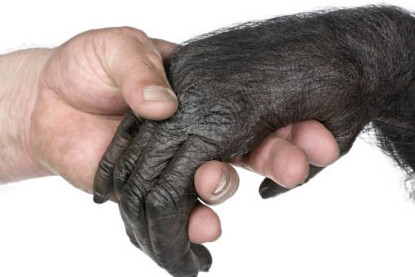
近日,国际杂志Nature上刊登了一篇名为“The evolution of human and ape hand proportions”的文章,文章中,来自石溪大学的科学家通过研究发现,人类的手掌或许比黑猩猩地还要原始。
从人类和黑猩猩最后共同的祖先进化至今,人类手掌的大小仅发生了一点改变,本文研究结果表明,现代人手掌的结构从本质上来讲较为原始,而这并不是石器时代选择性压力所引发的的结果。
人类的手在手指上主要表现为较长的拇指,而这是人类相比猿类而言拥有的最为独特的特征,而通常这也被认为是一个物种获得成功的主要原因;然而目前有竞争性的理论揭示了人类的手掌随着时间流逝如何进行进化。
文章中研究者测定了人类、活的猿类、化石猿类以及人类祖先拉密达猿人和南方古猿的化石的手掌的大小,用于帮助理解手掌的逐步进化,研究结果表明,黑猩猩和猩猩在手指的伸长方面出现了趋同进化的表现,而人类、人类的祖先及大猩猩在手指伸长方面却变化并不大。
相关研究结果支持了科学家此前的假设,即人类手掌拇指和手指的比率和其它高度灵巧的类人猿一样都具有后天的趋同一致性,而该研究同时也挑战了科学家的另一种假设,该假设认为类似于黑猩猩的手掌只是黑猩猩和人类共同祖先手掌进化的起点。
本文系生物谷原创编译整理,欢迎转载!转载请注明来源并附原文链接。更多资讯请下载生物谷APP.
The evolution of human and ape hand proportions
Sergio Almécija, Jeroen B. Smaers & William L. Jungers
Human hands are distinguished from apes by possessing longer thumbs relative to fingers. However, this simple ape-human dichotomy fails to provide an adequate framework for testing competing hypotheses of human evolution and for reconstructing the morphology of the last common ancestor (LCA) of humans and chimpanzees. We inspect human and ape hand-length proportions using phylogenetically informed morphometric analyses and test alternative models of evolution along the anthropoid tree of life, including fossils like the plesiomorphic ape Proconsul heseloni and the hominins Ardipithecus ramidus and Australopithecus sediba. Our results reveal high levels of hand disparity among modern hominoids, which are explained by different evolutionary processes: autapomorphic evolution in hylobatids (extreme digital and thumb elongation), convergent adaptation between chimpanzees and orangutans (digital elongation) and comparatively little change in gorillas and hominins. The human (and australopith) high thumb-to-digits ratio required little change since the LCA, and was acquired convergently with other highly dexterous anthropoids. /P>
